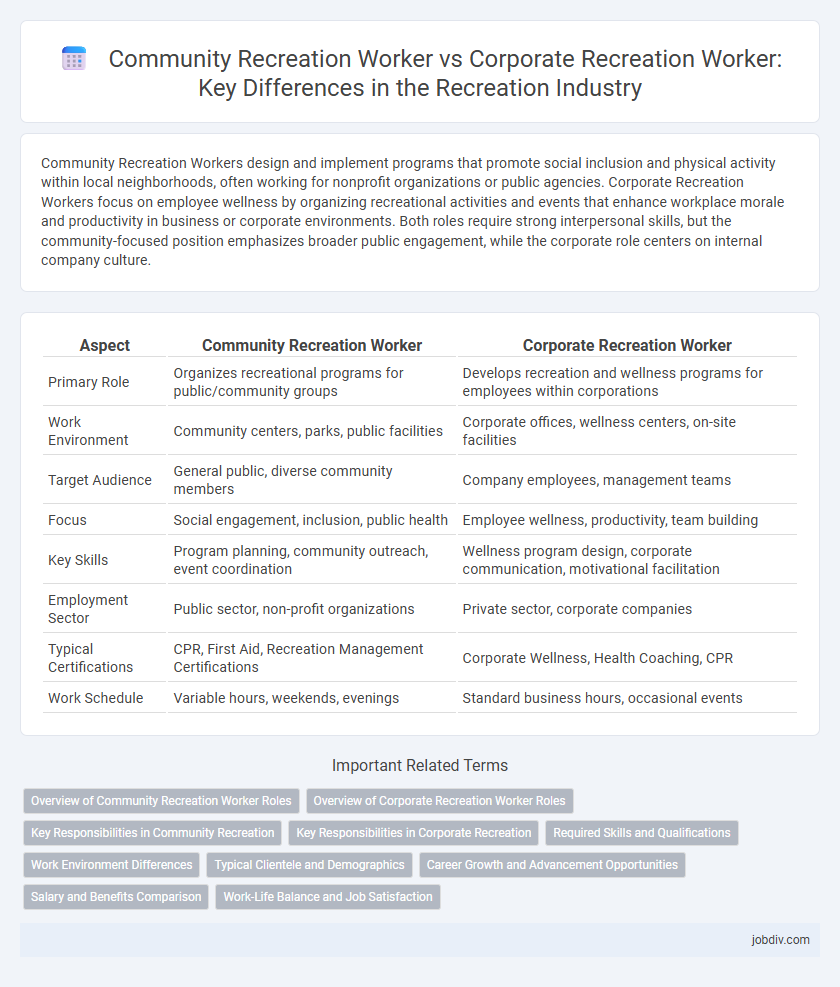Community Recreation Workers design and implement programs that promote social inclusion and physical activity within local neighborhoods, often working for nonprofit organizations or public agencies. Corporate Recreation Workers focus on employee wellness by organizing recreational activities and events that enhance workplace morale and productivity in business or corporate environments. Both roles require strong interpersonal skills, but the community-focused position emphasizes broader public engagement, while the corporate role centers on internal company culture.
Table of Comparison
| Aspect | Community Recreation Worker | Corporate Recreation Worker |
|---|---|---|
| Primary Role | Organizes recreational programs for public/community groups | Develops recreation and wellness programs for employees within corporations |
| Work Environment | Community centers, parks, public facilities | Corporate offices, wellness centers, on-site facilities |
| Target Audience | General public, diverse community members | Company employees, management teams |
| Focus | Social engagement, inclusion, public health | Employee wellness, productivity, team building |
| Key Skills | Program planning, community outreach, event coordination | Wellness program design, corporate communication, motivational facilitation |
| Employment Sector | Public sector, non-profit organizations | Private sector, corporate companies |
| Typical Certifications | CPR, First Aid, Recreation Management Certifications | Corporate Wellness, Health Coaching, CPR |
| Work Schedule | Variable hours, weekends, evenings | Standard business hours, occasional events |
Overview of Community Recreation Worker Roles
Community Recreation Workers facilitate inclusive programs that promote social engagement, physical activity, and cultural enrichment within local neighborhoods, often collaborating with public agencies and nonprofit organizations. They design and implement recreational activities tailored to diverse populations, focusing on enhancing community well-being and fostering social cohesion. Their role emphasizes accessibility, volunteer coordination, and resource management to support sustainable, community-centered recreation initiatives.
Overview of Corporate Recreation Worker Roles
Corporate Recreation Workers design and implement wellness programs tailored to enhance employee engagement and productivity within organizations. Their roles often include organizing team-building activities, managing corporate fitness initiatives, and coordinating recreational events that promote workplace morale. These professionals collaborate closely with human resources to align recreational offerings with company culture and employee well-being goals.
Key Responsibilities in Community Recreation
Community Recreation Workers design and implement inclusive programs that promote wellness, social interaction, and cultural enrichment within local neighborhoods. They collaborate with community members, schools, and organizations to organize events, recreational activities, and educational workshops tailored to diverse populations. Their key responsibilities include facilitating access to recreational resources, ensuring safety standards, and fostering community engagement to enhance quality of life.
Key Responsibilities in Corporate Recreation
Corporate Recreation Workers design and implement wellness programs aimed at enhancing employee health, engagement, and productivity within organizations. They coordinate team-building activities, fitness challenges, and recreational events tailored to corporate culture and goals. Emphasis is placed on fostering a positive work environment through strategic planning and collaboration with management and human resources departments.
Required Skills and Qualifications
Community Recreation Workers require strong interpersonal skills, cultural sensitivity, and knowledge of local regulations to effectively engage diverse populations and organize inclusive programs. Corporate Recreation Workers need expertise in event planning, risk management, and corporate wellness strategies, often supported by certifications in health promotion or human resources. Both roles benefit from strong communication and teamwork abilities, but corporate positions may demand advanced business acumen and proficiency in digital wellness platforms.
Work Environment Differences
Community Recreation Workers typically operate in public or nonprofit settings such as parks, community centers, and local recreational facilities, engaging directly with diverse populations to promote wellness and social inclusion. Corporate Recreation Workers are employed by private companies or organizations, focusing on designing and managing employee wellness programs, team-building activities, and recreational events within a controlled workplace environment. The work environment for Community Recreation Workers is often dynamic and public-facing, while Corporate Recreation Workers usually experience structured office or corporate campus settings.
Typical Clientele and Demographics
Community Recreation Workers primarily serve diverse groups including families, seniors, and youth from various socioeconomic backgrounds in public parks and community centers. Corporate Recreation Workers typically cater to employees and management teams within private companies, focusing on enhancing workplace morale and team building. Both roles address unique demographic needs, with community workers often engaging broader populations and corporate workers targeting organizational subgroups.
Career Growth and Advancement Opportunities
Community recreation workers often experience career growth through public sector promotions and specialized certifications related to youth programs or social services, benefiting from strong local government support. Corporate recreation workers typically advance by acquiring skills in event management, corporate wellness, and client relations, leading to leadership roles in private companies or consultancy positions. Both career paths demand ongoing professional development, but corporate roles may offer faster salary growth due to profit-driven environments, while community roles provide more stable long-term benefits.
Salary and Benefits Comparison
Community Recreation Workers typically earn a median salary of $35,000 to $45,000 annually, while Corporate Recreation Workers often receive higher compensation ranging from $50,000 to $65,000, reflecting the corporate sector's increased budget allocations. Benefits in community roles usually include government-sponsored health plans and pension schemes, whereas corporate positions offer comprehensive packages with bonuses, stock options, and wellness programs. Job security tends to be stronger in community roles due to government funding, contrasting with performance-based incentives prevalent in corporate recreation employment.
Work-Life Balance and Job Satisfaction
Community Recreation Workers often experience greater work-life balance due to more flexible schedules and stronger community engagement, which enhances overall job satisfaction. Corporate Recreation Workers typically face structured hours and performance-driven environments that can increase stress but offer higher financial rewards. Job satisfaction for Community Recreation Workers is closely tied to social impact, while Corporate Recreation Workers find fulfillment through career advancement and organizational goals.
Community Recreation Worker vs Corporate Recreation Worker Infographic

 jobdiv.com
jobdiv.com